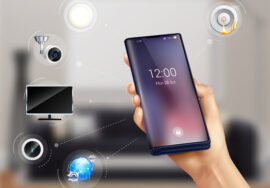
AI in Your Pocket: Latest Trends in Smartphones with Built-in Generative AI Assistants
Introduction: The Era of AI-Powered Smartphones
The smartphone has always been a symbol of innovation, evolving from simple calling devices to pocket-sized computers. But in 2025, a new revolution is underway—generative AI assistants built directly into smartphones. Unlike traditional voice assistants, these new AI systems can understand context, generate content, and even anticipate user needs in real time. They mark a turning point in the evolution of Electronics & Gadgets, blending intelligence with portability to create a more personal digital companion.
What Makes Generative AI Assistants Different?
Earlier AI systems on phones were limited to answering simple questions or performing voice-activated commands. Generative AI assistants, however, are powered by advanced language models that can produce text, images, and even code. They go beyond reactive tasks and engage in predictive interactions, learning from user habits to deliver proactive solutions. For example, instead of just setting a reminder, an AI assistant can suggest optimal meeting times, draft an email, and summarize previous conversations to prepare the user.
AI as a Productivity Partner
One of the strongest appeals of generative AI in smartphones is its ability to act as a real productivity partner. Business professionals can dictate quick notes and have them turned into polished documents. Students can request study summaries, while freelancers can generate creative ideas or social media captions instantly. With built-in integration, these assistants are accessible offline in some cases, reducing reliance on cloud services. This makes smartphones equipped with generative AI invaluable Electronics & Gadgets for professionals on the go.
Enhanced Creativity at Your Fingertips
Creativity is no longer confined to specialized apps. AI-powered smartphones allow users to create presentations, music, or visual art directly from their devices. For instance, a user could describe a concept, and the AI assistant would generate a design draft or suggest multiple creative variations. Photographers and content creators also benefit from AI features like automated photo enhancement, background removal, or video script generation, turning the smartphone into a portable creative studio.
Personalized Experiences Through AI Learning
Generative AI assistants stand out because they adapt continuously to the user. By analyzing communication styles, browsing behavior, and task preferences, they offer more personalized experiences. Imagine unlocking your phone and receiving not just a weather forecast, but also tailored advice like when to leave for your next appointment based on real-time traffic. This personalization transforms smartphones into highly intuitive Electronics & Gadgets that grow smarter the more they’re used.
Generative AI in Communication
Communication is at the heart of smartphones, and AI assistants are making it more dynamic than ever. Features such as real-time translation, auto-drafted replies, and voice-to-text enhancements are becoming standard. In 2025, AI-powered smartphones can even simulate your writing style, ensuring professional emails or casual chats sound authentically you. For businesses, this means faster client response times, while for everyday users, it means smoother communication across cultures and contexts.
Privacy and Ethical Considerations
While the benefits are immense, there are also challenges tied to privacy and ethics. AI assistants that constantly learn from user data raise concerns about how securely that data is stored and processed. Smartphone manufacturers are increasingly focusing on on-device AI processing, ensuring sensitive information never leaves the user’s phone. Striking the right balance between personalization and privacy is crucial for the long-term success of AI-powered Electronics & Gadgets.
Key Smartphone Trends with AI in 2025
Several smartphone trends are shaping the market this year, driven by the integration of generative AI:
- Offline AI Processing: Reduced dependence on the cloud ensures quicker responses and greater data security.
- Multi-Modal AI Capabilities: Assistants now combine text, voice, and image recognition for seamless interactions.
- Contextual Awareness: Phones adjust notifications, battery use, and performance settings based on daily routines.
- AI-Augmented Cameras: Generative AI creates realistic image enhancements, background fills, or even “AI Zoom” for higher-quality photography.
- Battery Efficiency: AI manages resources, predicting app usage patterns and extending battery life.
These trends position AI-powered smartphones not just as communication devices, but as all-in-one lifestyle tools.
Competition Among Smartphone Brands
Major brands are competing aggressively to integrate the most advanced AI assistants. Apple is enhancing Siri with generative capabilities, focusing on ecosystem integration. Samsung’s Galaxy AI emphasizes real-time translation and productivity. Google is embedding its Gemini AI assistant into Pixel devices for deep contextual understanding. Meanwhile, emerging brands from China are rolling out budget-friendly AI-equipped smartphones, making advanced features accessible to more users. This competition is driving rapid innovation in the Electronics & Gadgets market.
The Role of AI in Gaming and Entertainment
Beyond productivity, generative AI is reshaping mobile gaming and entertainment. Smartphones now offer AI-enhanced gaming assistants that optimize performance settings, suggest strategies, or even generate custom in-game content. Streaming apps integrate AI for personalized recommendations and automated summaries of missed episodes. These features highlight the growing overlap between smartphones, entertainment hubs, and AI-powered creativity.
The Future of AI in Your Pocket
Looking ahead, smartphones may evolve into full-scale personal AI hubs. With advancements in multi-agent AI systems, future devices could host specialized assistants—one for health, one for finance, one for work—all coordinating to deliver a unified experience. Hardware upgrades such as neuromorphic chips will further boost processing power, enabling real-time learning without draining battery life. These developments suggest that AI-driven smartphones are not just a trend but the foundation of next-generation Electronics & Gadgets.
Conclusion: A New Standard for Smartphones
Generative AI assistants have transformed smartphones into far more than communication tools. They are now creative partners, productivity boosters, and personalized advisors. CES 2025 and recent smartphone launches confirm one truth: the future of mobile technology lies in AI that understands, creates, and adapts. For consumers, this means carrying an intelligent companion in their pocket, ready to assist with work, play, and everything in between. In the rapidly advancing world of Electronics & Gadgets, AI-powered smartphones are setting a new standard—and they’re here to stay.







